SLC21/WK6: Electricity bill and Electrical Cable, Circuit Breaker size Calculation.
Steemian Friends,
Today, we will write last week's lesson on Steemit Learning Challenges 21 for students. Today, we will teach students how to prepare their own home or office electricity bills and calculate the electrical load to calculate the cable size. Basic electricity is such a subject that it is impossible to cover it in six weeks. So we will apply to teach some more topics of basic electricity in the next learning challenge 22. If the Steemit Team gives us a chance, we will return with some important lessons of basic electricity. So let's start the last week's lesson.
.png)
Design By Canva
We have been learning about electricity for the past five weeks. In particular, we have learned how to calculate electrical loads. Today, we will learn the rules for calculating the electricity bill by calculating the electricity load.
I have given the list of electrical home appliances in my house below. Electricity companies make some rules to prepare electricity bills. Like LT load and HT load as per customer demand.
Our household distribution lines are treated as LT load. LT load divides the consumer's demand into phases such as 3 kW, 5 kW, 10 kW, and so on. The electrical feeders are then identified as LT1, LT2 and LT3. The higher the electrical load the unit price of electricity will increase step by step.
HT load is in the industrial sector and large residential buildings where mega-watt electricity is consumed. For example, I am an electrical engineer in a rod company. My substation has 20 MW of power. Hence, our company is identified as an HT1 feeder. For small companies in the industrial sector, the electrical feeders are designated as HT1, HT2, and HT3, respectively. Our students will understand electrical loads and electrical feeders.
Power companies divide the time into two periods based on the customer's demand for electricity. One is peak hour, and the other is off-peak hour. We have written about peak and off-peak hours below.
Peak Hour:
The period during which people consume the most electricity at night and during the day is called peak hour. Power companies consider 5.00 pm to 11.00 pm as peak hours. Electricity bills are charged higher during peak hours. Find out the peak hours of your country.
Off-peak hours:
During off-peak hours, electricity companies think people use less. So the power company counts off-peak hours from 11.00 pm to 5.00 pm. Electricity bill prices are lower during off-peak hours. So our advice would be to run large household electrical loads during off-peak hours.
We will first learn to calculate the electricity bill from LT load. I am taking out the electricity bill for my house and showing it below.
In my house, three lights of 30 watts are on for 5 hours per day, four fans of 70 watts are on for 6 hours per day, and a room heater of 70 watts is on for 3 hours per day. Our electricity company's electricity bill per unit is 0.15 Steem. How much will my electricity bill be in November 2024?
Solution:
Formula to calculate electricity consumption: Watts * Number of loads * Hours
Electricity consumption of the lamp per day:
= Watts * Number of loads * Hours = 30 *3 * 5
= 450 WH
= 0.45 KWH [1 KW = 1000 Watt]
Electricity consumption of the Fans per day:
= Watts * Number of loads * Hours
= 70 * 4 * 6
= 1680 WH
= 1.68 KWH
Electricity consumption of the room heater per day:
= Watts * Number of loads * Hours
= 70 * 1 * 3
= 210 WH
= 0.21 KWH
Total electricity consumption in a day:
= Lamps + Fans + Room heater
= (0.45 + 1.68 + 0.21) KWH
= 2.34 KWH
= 2.34 Unit[ 1 KWH = 1 Unit]
Total electricity consumption for November 2024:
= Total electricity consumption in a day * 30 [November Month= 30 Days]
= 2.34 * 30
= 70.2 KWH
= 70.2 Units
Electricity Bill Per unit = 0.15 Steem
Total electricity bill for November 2024:
= Total electricity consumption for November 2024 * Per Unit cost
= 70.2 * 0.15
= 10.53 Steem(Ans.)
HT Meter Reading:
| Date | R1(Peak) | R2(Off Peak) | Total KWH |
|---|---|---|---|
| 01-11-2024 | 2625.20 KWH | 9692.81 KWH | 12318.01 |
| 30-11-2024 | 2665.26 KWH | 9825.21 KWH | 12490.47 |
| Peak Rate | 1.5 Steem |
|---|---|
| Off-Peak Rate | 1.0 Steem |
Formula:
R1(Peak)=(2665.26-2625.20)KWH * 18000= ?
R2(Off Peak)=(9825.21-9692.81)KWH * 18000= ?
Total KWH = R1 +R2 = ?
Total KWH = (12490.47-12318.01)KWH = R1 + R2
Total Electricity Bill = R1(Peak) * 0.15 = ? [Per Unit cost = 0.15 Steem(Peak)]
Total Electricity Bill = R2(Off Peak) * 0.10 = ? [Per Unit cost = 0.10 Steem(Off-Peak)]
1 KWH = 1 unit
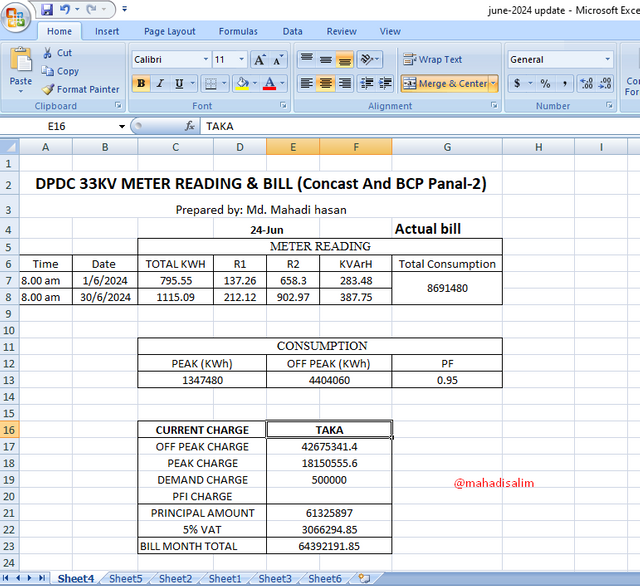
My electricity bill design
There are two types of cable based on the use of the cable.
- XLPE cable
- PVC cable
XLPE cable:
The full form of XLPE is Cross-Linked Polyethylene. This cable is used in high-voltage lines. XLPE cables are used for the electrical connection of lines above 33 KV. XLPE cables cost more. This cable is temperature resistant up to 90 degrees Celsius. The durability of this cable is very high.

XLPE 33KV HT Cable(1 * 300) RM
PVC cable:
The full form of PVC is Polyvinyl Chloride. PVC cable is used in low-voltage line work. These cables are used in lines up to 11 KV maximum. It can withstand temperatures up to 70 degrees Celsius. This cable is mostly used in building electrical wiring. The durability of this cable is short. PVC cable is cheaper than XLPE cable.
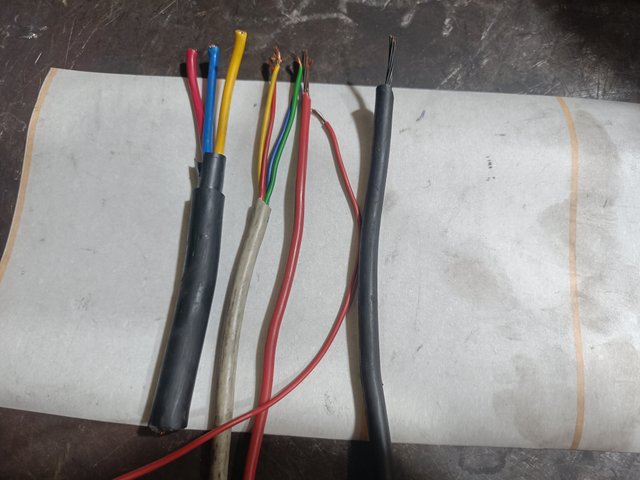
PVC Cable
Below, we have given names and descriptions of some cables based on their electrical function.
Single-core cable:
Most cables we use for home electrical connections are single-core. We can understand the single-core cable by looking at the cable. A wire has insulation. We have given a picture of the single-core cable below. Single core cable (1-500) sizes up to RM. Such cables are used on the low-voltage side. Hope you have learned about single-core cable.
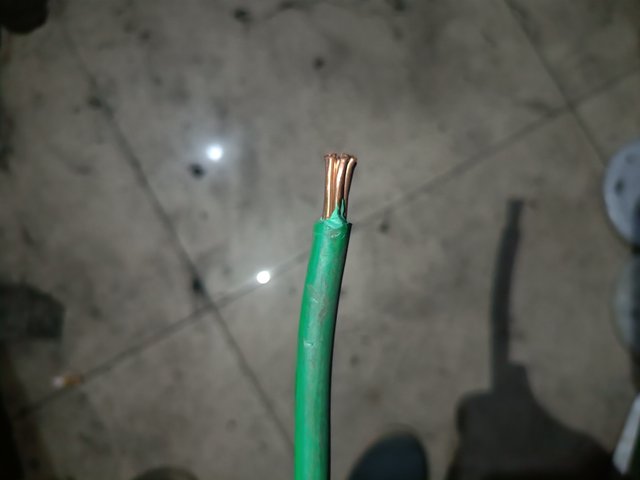
1 * 2 RM Cable
Two-core cable:
If there are two cores or cables inside an insulation cable, we call it a core cable. Two core cables are used in home appliances where loads are electrically connected through two wires, like a 220-volt motor, rice cooker, etc.
.jpg)
2 * 1.5 RM Cable
Three-Core Cable:
If there are three cores or wires inside an insulated cable, we call it a core cable. Three core cables consist of three wires of three colors, i.e., red, yellow, and black or green. We mostly use this cable when connecting three-phase motors. This cable is up to (1-300)RM on the low voltage side.
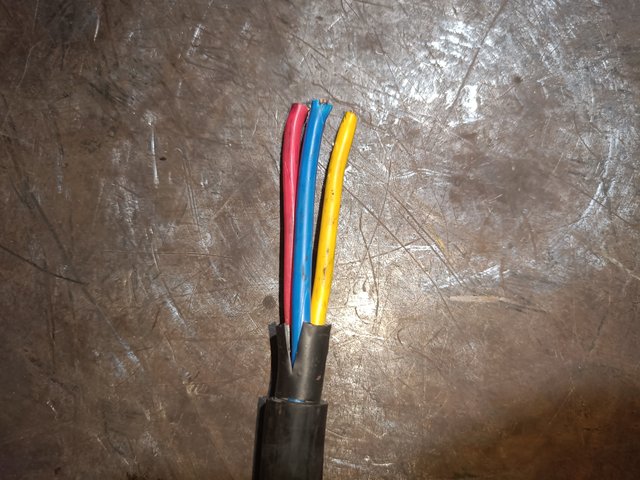
3 * 6 RM Cable
| Cable Size (RM/Sq mm) | Current Rating(A) | Load(Watt) | Circuit Breaker Size |
|---|---|---|---|
| 1.0 RM | (13-16)Amp | (900-1100)W | C06(6 Amp) |
| 1.5 RM | (16-20)Amp | (1100-1300)W | C06(6 Amp) |
| 2.0 RM | (20-25)Amp | (1300-1700)W | C10(10 Amp) |
| 2.5 RM | (22-28)Amp | (1500-1900)W | C10(10 Amp) |
| 4.0 RM | (30-37)Amp | (2000-2500)W | C16(16 Amp) |
| 6.0 RM | (38-47)Amp | (2600-3200)W | C20(20 Amp) |
| 10.0 RM | (52-63)Amp | (3500-4300)W | C32(32 Amp) |
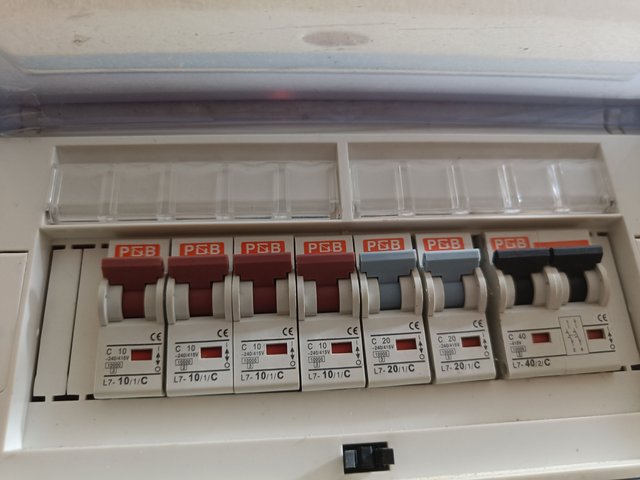
Circuit Breaker
Cable Size and Circuit Breaker Determination Formula:
We know,
Power, P= V * I * PF
= 220 * 13 * 0.9
= 2574 Watt
P = Power = ?
V = Voltage = 220 volts
I = Current = 13 Amp.
PF = Power factor = 0.9
Determine the cable size and circuit breaker from the above chart by dividing the total power by three.
P = 2574/3 = 858 Watt ~900 Watt
A 900-watt load would require a 1.00 RM cable and C06 (6 Amp) circuit breaker for that electrical home appliance load. Our students can select the cable size and circuit breaker by calculating the load.
A.
Write three key differences between XLPE and PVC cables.
Write three key differences between single-core, two-core, and three-core cables.
Write about peak and off-peak hours in your country.
B. Calculate your house load and prepare the electricity bill for November 2024 by following Example 1.
C. Calculate the total electricity bill with the HT meter values given in Example 2 and design an electricity bill in Excel.
D. Figure out the cable and circuit breaker sizes you need to setup a 20 ampere, 220 volts, and power factor (PF) 0.9 washing machine at home.
Marks Distribution:
| Sl. No | Marks |
|---|---|
| A | 2 Marks |
| B | 2 Marks |
| C | 3.5 Marks |
| D | 2.5 Marks |
- Your title should be "SLC21/WK6: Electricity bill and Electrical Cable, Circuit Breaker size Calculation."
- The content must be #steemexclusive.
- The article must contain the tag #electricity-s21w6.
- Plagiarism is not allowed.
- The link of your task must be added in the comments of this publication.
- Use the burnsteem25 tag only if you have set the 25% payout to @null.
- You can publish homework in any community and in any language. But don't forget to use the original tag.
- Invite three of your active Steemian friends.
- The participation schedule is between Monday, December 02, 2024, at 00:00 UTC to Sunday, - December 08, 2024, at 23:59 UTC.
SC01/SC02 would check on the entire 17 participating Teaching Teams and Challengers and upvote outstanding content. Upvotes are not guaranteed for all articles.
At the end of the week, we would nominate the top 4 users who had performed well in the contest and would be eligible for votes from SC01/SC02.

Best Regards,
Basic Electricity Teaching Team
@mahadisalim
@solaymann



Here is my entry:
https://steemit.com/hive-118902/@ahsansharif/slc21-wk6-electricity-bill-and-electrical-cable-circuit-breaker-size-calculation
This is my Twitter share link :
https://twitter.com/mahadih83660186/status/1863120083100586202?t=1psIj-5zVMM0i5OI2jMZMw&s=19
Please professor I need a little clarification on question C
Going through your lesson and example B, I want to know if the bill prepared in excel is related to the HT meter provided. I have try to match the information but not getting it. Please can you help throw a little light. I want to know if the excel is just a template or the information from it was gotten based on the HT meter table
Dear, you can put the HT meter values in Excel and calculate the result. You will design the excel seat as you like.
If you have trouble understanding, you can ask more questions.
Thanks for your quick responses it is highly appreciated.
https://steemit.com/hive-147599/@simonnwigwe/slc21-wk6-electricity-bill-and-electrical-cable-circuit-breaker-size-calculation
My entry
https://steemit.com/hive-118902/@hisgeneral/slc21-wk6-electricity-bill-and-electrical-cable-circuit-breaker-size-calculation
My link
https://steemit.com/electricity-s21w6/@josepha/slc21-wk6-electricity-bill-and-electrical-cable-circuit-breaker-size-calculation
my entry post https://steemit.com/electricity-s21w6/@hamzayousafzai/slc21-wk6-electricity-bill-and-electrical-cable-circuit-breaker-size-calculation
My entry
https://steemit.com/electricity-s21w6/@rossnenye/slc21-wk6-electricity-bill-and-electrical-cable-circuit-breaker-size-calculation
My entry; https://steemit.com/hive-180106/@sisol/slc21-wk6-electricity-bill-and-electrical-cable-circuit-breaker-size-calculation
my participation link
https://steemit.com/hive-180106/@hamidrizwan/slc21-wk6-electricity-bill-and-electrical-cable-circuit-breaker-size-calculation